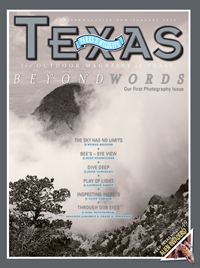
Why We Shoot
Our chief photographer explores the psychology of photography.
By Earl Nottingham
It’s a simple question that I often ask of other photographers — one that even a seasoned pro can have difficulty answering and, as rhetorical questions go, causes an individual to look below the surface and find a deeper truth.
Why do you take pictures?
After a contemplative pause, my colleague Wyman Meinzer answers that question in halting and measured beats. “I take pictures … because … number one … I can’t draw.” Only with further probing does the underlying truth emerge as to why he chooses photography as an occupation.
“When I see beautiful light on a landscape, I get an emotional rush,” Wyman says. “A photograph is my way of sharing that emotion with others. The camera is my paintbrush.”
Implicit in his observation is that the camera, like a paintbrush, is a means to an end — a tool that allows his inner artist to share an experience and the emotions that go with it.
Joseph Niepce, another visionary who also lacked painterly talents, might have asked himself the same “why” question in 1826 as he developed the first faint photographic image of a French farmhouse on a piece of sensitized pewter, ushering in the magic of photography and creating a new palette composed of light.
Since the creation of that memorable image, photographic processes have evolved from time-consuming chemical-based processes of creating images to simpler and commercialized methods that allowed the masses to enjoy photography.
Today, the electronic image is rapidly replacing traditional film in its ability to not only take a quality photograph but also to then instantly share it with the world. The camera has become the tool of choice in documenting life as it happens, and statistically there is a good chance that, at any given time, most of us have some type of camera with us and for each of us there is a “why.”
Those reasons are as unique as the number of individuals behind the cameras and yet, there are some basic similarities. Many use photography primarily as a tool to remember and savor the fleeting moments in life.
As French photographer Henri Cartier-Bresson noted, “Photographers deal in things which are continually vanishing and when they have vanished there is no contrivance on earth which can make them come back again.” Generations of treasured family albums attest to the power of a photograph to let us re-visit the past and re-kindle emotions.
Others pursue the “trophy” aspect of photography — a challenge for the perfect picture. The wildlife photographer will spend days on end returning to a cold blind waiting for the perfect animal, as will the landscape photographer waiting atop the summit for the perfect mix of light and subject.
The quest to get the perfect photo becomes a hunt, and the photographer the hunter. Interestingly, many traditional hunters now prefer to shoot with a camera rather than a gun.
In the end, every individual has a reason for enjoying photography. However, there is one common underlying (perhaps subconscious) commonality that unites us.
Whether photographing a gorgeous sunset, the delicate patterns of a butterfly wing or a child’s smile, the simple act of taking a photograph forces us to pause our lives for a brief moment while concentrating on the scene in the viewfinder.
In a helter-skelter world that seems to be spinning faster each day, the click of the camera shutter gives us an opportunity to do the impossible — to arrest time for one precious fraction of a second. The resulting image provides a respite with which to appreciate and savor the moment.
Dorothea Lange, known for her striking documentary photographs of the Great Depression, noted, “The camera is an instrument that teaches people how to see without a camera.”
Quite simply, the camera is merely a tool that gives us the opportunity – and possibly a need — to pause life momentarily and to re-affirm that we are participants in its magnificence.
The photograph is just the evidence.
